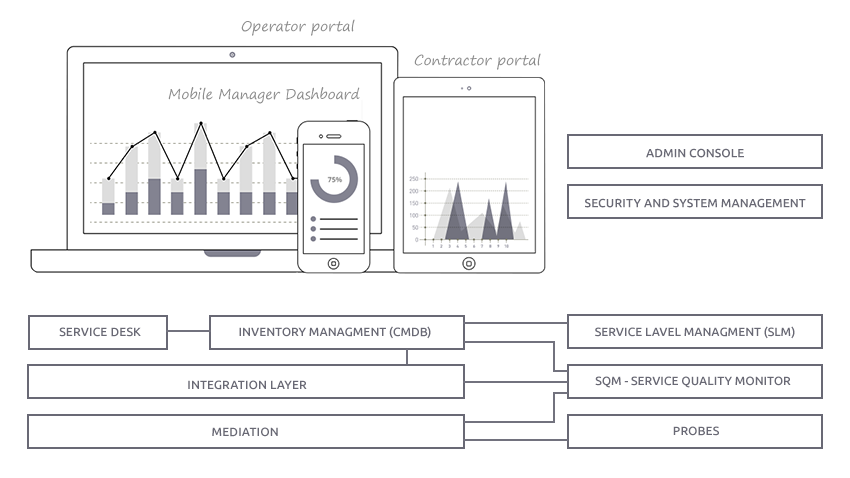Home ›
wiSLA Platform Architecture and Composition
The development of the wiSLA (well integrated SLA) platform was based on standards and best practices of creating OSS / BSS systems, which are described in templates of TM Forum NGOSS:
-
Enhanced Telecom Operations Map (eTOM)
-
Shared Information/Data Model – SID
-
Telecom Applications Map – TAM
-
Integration Framework
When developing the system, other, no less important, standards were also used, i.e. ITIL and TOGAF.
The wiSLA platform is built according to classical methods of tiered enterprise applications Java 2 Platform, Enterprise Edition (J2EE) using architectural patterns:
-
Distributed Architecture
-
Loosely Coupled Links
Also, based on the development trends of common international standards and programs (TM Forum → NGOSS → OSS / BSS → OSS / J), it becomes apparent that the next-generation wiSLA platform must be compliant with the OSS / J technical program.
Structure of wiSLA architecture:

Mediation subsystem provides two-way communication of the system with hardware and software probes, databases, and information in different formats (XML, CSV, SNMP, CLI, SSH, and telnet).
Service Level Management (SLM) subsystem ensures execution of the set of basic functions within the automation of the process of service quality management, and provides for the efficient management of relations with customers and service providers. At the end of reporting period, the SLM subsystem generates SLA reports, calculates discounts for breaches of SLA subject to exclusions and scheduled maintenance reports. To generate ad hoc reports, the SLM uses Business Intelligence and Reporting Tools (BIRT), which allows for the prompt generation of reports necessary to users.
Service Quality Monitoring (SQM) subsystem provides continuous real-time monitoring of the service quality. SQM compares service quality indicators with values in SLAs in every moment and defines the status of the service. SQM-monitor, based on Java Message Service, builds the core of SQM. To improve the efficiency of processing a huge stream of data coming from probes, the HBase non-relational distributed database is used. This technology is used by the Facebook service to process more than 35 billion messages per month from users across the world.
Inventory subsystem provides accounting and management of the infrastructure of controlled services and measuring devices. The subsystem caters for relationships between certain entities as the contractor, contract, services, access points, measuring devices, and tests. According to TAM, the Inventory subsystem performs such functions as Resource Inventory, Service Inventory, and Customer Inventory (CRM). The Inventory subsystem also stores KPI / KQI chains related to the services.
Integration Framework, based on the service-oriented architecture (SOA) and open interfaces (WSDL / SOAP / XML). wiSLA contains pre-integrated modules for existing Trouble Ticketing, Fault Management, and Order Management systems, as well as modules for external Customer web portals. Additionally, as part of the Integration Framework, the Business Process Management (BPM) module can be supplied.
Contractor External Portal to interact with users or providers of services, e.g. last mile / transit operators, at execution of the relevant SLAs, or customers, to which the SLA service is provided.
Operator Internal Portal is designed to control the system and offers advanced functionality, compared with the Contractor Portal. Web interfaces of the wiSLA platform are implemented using the latest technologies WEB2.0, AJAX, and HTML5.

wiSLA.Dashboard Mobile Manager Dashboard is designed for IT managers and provides prompt remote access to the most important functions of the system. wiSLA.Dashboard is a mobile application for Android and iOS. wiSLA.Dashboard interacts with the wiSLA system through the open REST API using SSL encryption.
Administrator Console is integrated into the Operator Portal and is designed to support the high-load systems operability with a large infrastructure, e.g. those of large carriers.
Desktop gadget for Windows Vista / Windows 7 is a version of Mobile Manager Dashboard adapted for Windows, and additionally is a convenient means of background monitoring of controlled services. The wiSLA gadget is implemented on standardized HTML and Java Script technologies.
In addition, depending on the tasks to be solved in a specific project, the wiSLA platform architecture can be supplemented with functional expansion modules:
-
Order Management subsystem – wiSLA.OM
-
Fault Management (Service Desk) subsystem – wiSLA.TT
-
Customer Experience Management subsystem – wiSLA.wiTest

